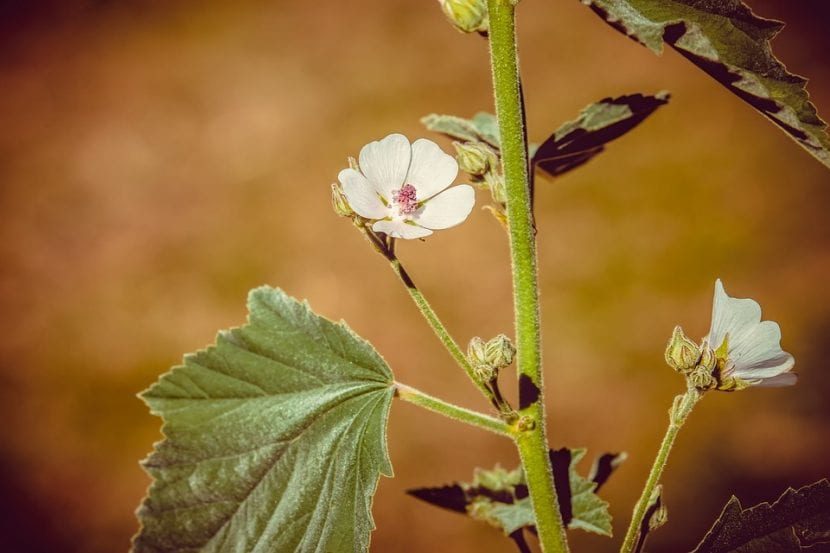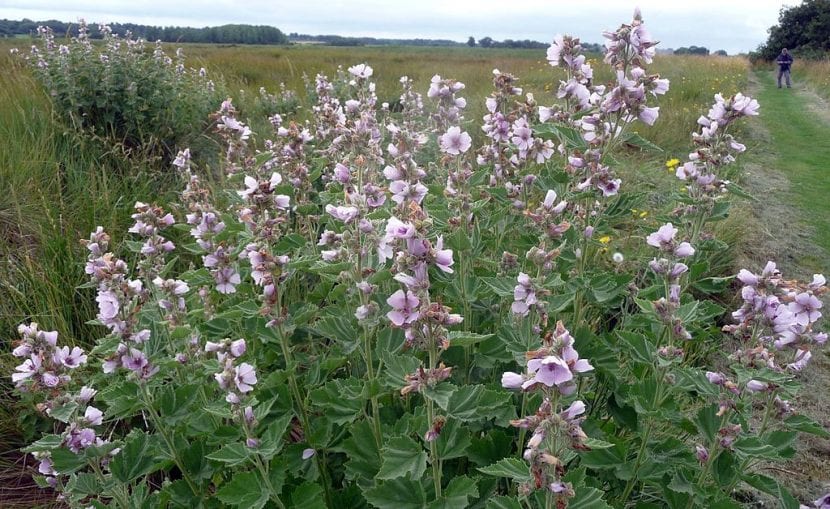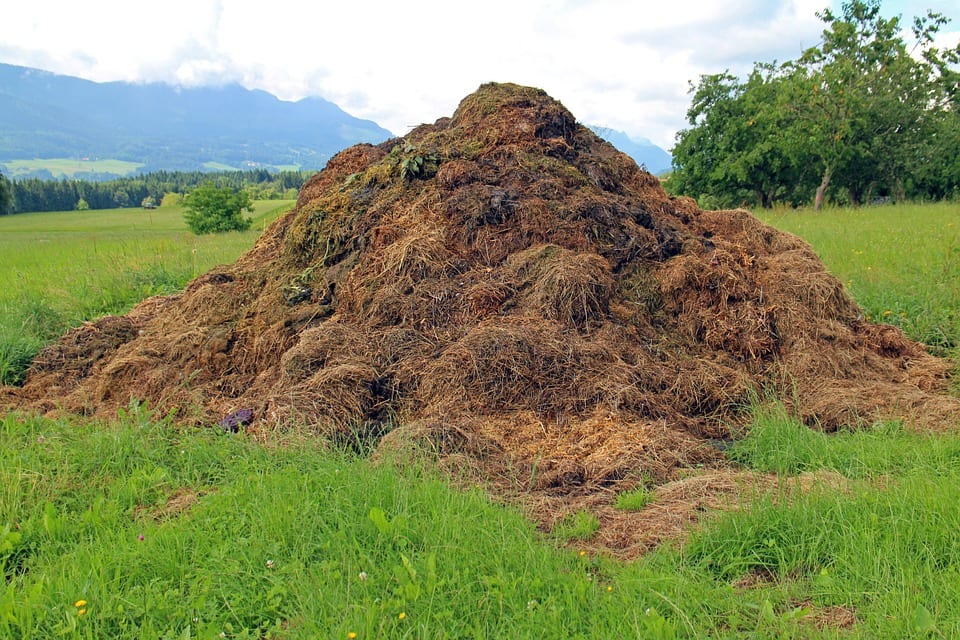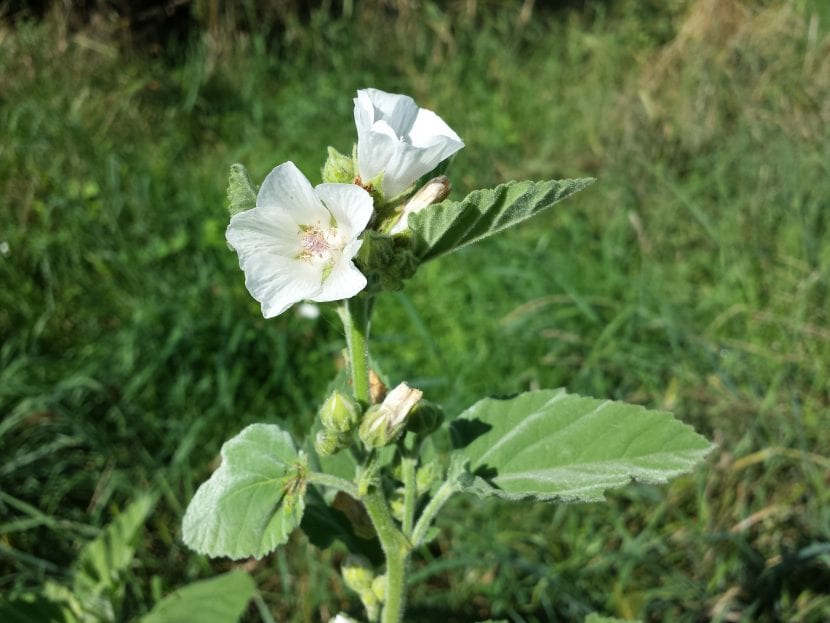
The plant known as marshmallow it is one of the most common in the meadows and open fields of Europe. It is the typical one that is easily distinguished, due to the height it reaches and its beautiful flowers that sprout during spring.
If you would like to have a garden or a terrace decorated in a rustic style, one of the plants that you cannot miss is this, not only because of its more than interesting ornamental value, but also because of how easy it is to take care of. Discover it.
Origin and characteristics of the marshmallow

Image - Wikimedia / Gailhampshire from Cradley, Malvern, UK
It is a perennial herb native to Eurasia whose scientific name is Althaea. It receives the names of bismallow, cane grass and marshmallow. It can reach a meter and a half height, with little or no branching stems growing upright., which develop from roots that are thick and rich in starch.
The leaves are large, about 10cm long by 7cm wide, diamond-shaped and covered by short white hairs. The flowers sprout from inflorescences called fasciculate peduncles. They are white or pink in color, and are made up of 5 petals up to 2cm wide. The fruit is dry and contains several hairy green seeds.
What are the care you need?

Image - Wikimedia / Nadiatalent
If you dare to have a copy, we recommend giving it the care that we tell you below:
Location
The marshmallow is a plant that has to be outside, in full sun. It is very, very important that it be placed in an area where it receives as many hours of direct sunlight as possible so that it can develop without problems.
Earth
- Flower pot: not demanding. You can fill it with universal substrate that they already sell prepared in any nursery, garden store or here same.
- Garden: grows on all types of soils, even alkaline ones. In any case, if the one you have is very compact, with poor drainage, it is advisable to make a planting hole of about 50cm x 50cm, and fill it with universal substrate.
Irrigation
It has to be watered from time to time, preventing the soil from drying out completely as well as waterlogging. Ideally, if in doubt, check the substrate moisture beforehand, with a digital moisture meter, or by inserting a thin wooden stick.
However, you should know that if, for example, the weather is very hot and dry, you may need about 3 waterings per week during the summer and 1-2 per week during the rest of the seasons. When you water, do not wet the leaves or flowers as they could burn if the sun hits them at that time.
Subscriber

Image - Wikimedia / Karelj
It is advisable to fertilize the marshmallow in spring and summer with liquid fertilizers if it is potted or powder or granulated if it is in the garden. In this way, you get him to grow stronger and healthier, with a defense system that will help him to be better.
To do this, you can use compost, guano, egg and / or banana shells, ... or any other following the instructions specified on the product packaging.

Multiplication
Marshmallow multiplies by seeds in spring following this step by step:
- First, fill a seedbed (seedling tray, pots, yogurt or milk containers, ...) with universal substrate or, if you prefer, with mulch (for sale here) or specific soil for seedbeds (for sale here).
- Then, place the seeds on the surface, so that they are as far apart as possible, avoiding making piles.
- Then cover them with a thin layer (no more than 0,5cm thick) of substrate and water.
- Next, place the seedbed outside in full sun.
- Lastly, keep the substrate always moist but not waterlogged.
You will have new specimens in about 15 to 20 days, which you can transplant as soon as you see the roots come out of the drainage holes.
Planting or transplanting time
The time to plant them in the garden is in spring, when the minimum temperature is higher than 15 degrees Celsius.
Rusticity
It is an herb that resists cold and frost up to -7ºC.
What uses is given to the marshmallow?

Image - Wikimedia / Stefan.lefnaer
Ornamental
It is a plant that produces very showy flowers, ideal to brighten up any sunny corner that you have in the garden, patio, terrace or balcony. As we have seen, it is very easy to take care of and multiply, so… what are you waiting for to have one? 😉
Medicinal
The marshmallow is a plant that takes advantage of practically everything: leaves, flowers and roots. Its properties are:
- Flowers: expectorants.
- Leaves: diuretic, demulcent and expectorant.
- Roots: expectorant, diuretic, demulcent and healing.
It can be taken as an infusion of leaves, syrup or poultice.
Culinary
The root is obtained in autumn, and you can consume it like any other vegetable, as for example in salads. Its nutritional value per 100 grams is as follows:
- Carbohydrates: 81,30g
- Sugars: 57,56g
- Fiber: 0,1g
- Fat: 0,20g
- Proteins: 1,80g
- Water: 16,40g
- Vitamin B1: 0,001mg
- Vitamin B2: 0,001mg
- Vitamin B3: 0,078mg
- Vitamin B6: 0,003mg
- Calcium: 3mg
- Iron: 0,23mg
- Magnesium: 2mg
- Phosphorus: 8mg
- Potassium: 5mg
- Sodium: 80mg
- Zinc: 0,04mg
What did you think of the marshmallow?